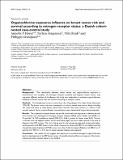| dc.contributor.author | Høyer, Annette P | |
| dc.contributor.author | Jørgensen, Torben | |
| dc.contributor.author | Rank, Fritz | |
| dc.contributor.author | Grandjean, Philippe | |
| dc.date.accessioned | 2018-02-02T21:23:31Z | |
| dc.date.issued | 2001 | |
| dc.identifier | Quick submit: 2017-09-21T13:24:45-0400 | |
| dc.identifier.citation | Høyer, Annette P, Torben Jørgensen, Fritz Rank, and Philippe Grandjean. 2001. “Organochlorine Exposures Influence on Breast Cancer Risk and Survival According to Estrogen Receptor Status: a Danish Cohort-Nested Case-Control Study.” BMC Cancer 1 (1) (July 30). doi:10.1186/1471-2407-1-8. | en_US |
| dc.identifier.issn | 1471-2407 | en_US |
| dc.identifier.uri | http://nrs.harvard.edu/urn-3:HUL.InstRepos:34776444 | |
| dc.description.abstract | Background
The relationship between breast cancer and organochlorine exposure is controversial and complex. As estrogen receptor positive and negative breast cancer may represent different entities of the disease, this study was undertaken to evaluate organochlorines influence on breast cancer risk and survival according to receptor status.
Methods
The background material stems from the Copenhagen City Heart Study (Denmark 1976-78). The breast cancer risk was investigated in a cohort nested case-control design including 161 cases and twice as many breast cancer free controls. The cases served as a cohort in the survival analysis. Serum organochlorine concentrations were determined by gaschromotography.
Results
The observed increased breast cancer risk associated with exposure to dieldrin derived from women who developed an estrogen receptor negative (ERN) tumor (Odds ratio [OR] I vs. IV quartile, 7.6, 95% confidence interval [95% CI] 1.4-46.1, p-value for linear trend 0.01). Tumors in women with the highest dieldrin serum level were larger and more often spread at the time of diagnosis than ERP tumors. The risk of dying was for the remaining evaluated compounds higher among patients with ERP breast cancer when compared to those with ERN. In the highest quartile of polychlorinated biphenyls (ΣPCB) it was more than 2-fold increased (Relative risk [RR] I vs. IV quartile, 2.5, 95% CI 1.1-5.7), but no dose-response relation was apparent.
Conclusion
The results do not suggest that exposure to potential estrogenic organochlorines leads to development of an ERP breast cancer. A possible adverse effect on prognosis of hormone-responsive breast cancers needs to be clarified. | en_US |
| dc.language.iso | en_US | en_US |
| dc.publisher | Springer Nature | en_US |
| dc.relation.isversionof | 10.1186/1471-2407-1-8 | en_US |
| dash.license | LAA | |
| dc.title | Organochlorine exposures influence on breast cancer risk and survival according to estrogen receptor status: a Danish cohort-nested case-control study | en_US |
| dc.type | Journal Article | en_US |
| dc.date.updated | 2017-09-21T17:24:48Z | |
| dc.description.version | Version of Record | en_US |
| dc.relation.journal | BMC Cancer | en_US |
| dash.depositing.author | Grandjean, Philippe | |
| dc.date.available | 2001 | |
| dc.date.available | 2018-02-02T21:23:31Z | |
| dc.identifier.doi | 10.1186/1471-2407-1-8 | * |
| dash.contributor.affiliated | Grandjean, Philippe | |


